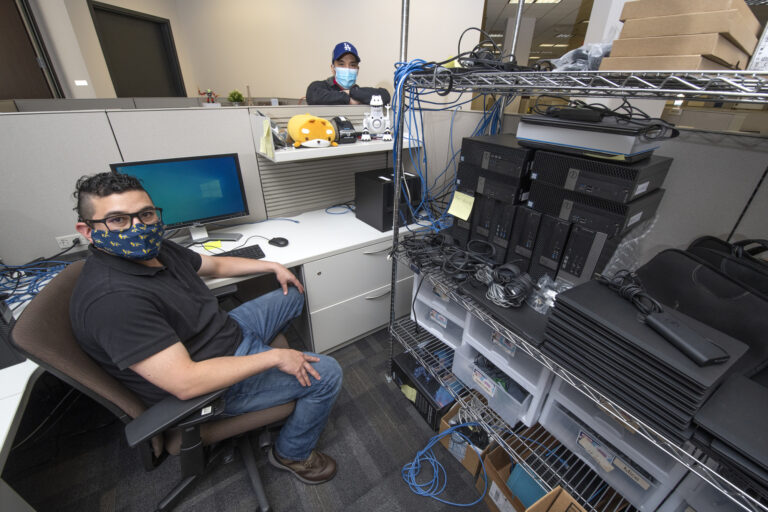By Sheri Ledbetter. Kian Colestock, associate vice chancellor and chief information officer in UCI’s Office of Information Technology, recalls the weekend in which he learned that his unit would be supporting the technological transition of a major research university to an all-remote environment.
“We told hundreds of staff in OIT on Friday, March 13, that we would do a practice run of being fully remote on Monday, the 16th,” Colestock says. “Over the weekend, Monday changed from a practice run into a live pilot. We’re still on that pilot, technically, as we’ve been remote ever since.”
OIT had been planning for this. Large screens in the main suite of the Anteater Learning Pavilion had been tracking the spread of COVID-19 on a world map since late January, following it from China as the circles of infections began growing. By February, the circles were crossing into other countries, and OIT leadership began running simulations for client services about what a remote environment might look like should the virus reach Southern California.
“We wanted to answer, ‘What if? Can we do our business if we can’t come to campus?’” Colestock says.
The initial week of UCI being fully remote was right before spring finals week, and the immediate need was to tell thousands of faculty how they were going to administer their exams. The Office of the Vice Provost for Teaching & Learning had to quickly come up with a strategy for final exams, including having OIT rapidly roll out proctoring software to allow students to take tests online.
Moving classes online on such short notice was not easy for faculty.
“There was an initial response of ‘This is impossible!’ followed by a more measured ‘Not only is this possible, but it’s necessary,’” says Vincent Olivieri, associate dean of graduate affairs in the Claire Trevor School of the Arts. “For me, understanding the strengths and limitations of the technology is essential. My field is sound design, which has a strong technical component. I leaned into the tech, using new-to-me tools to reach my students.”
Zoomtopia
During the week of spring break, OIT worked closely with campus leadership to figure out what was needed, not only for teaching and learning but also for staff to be remote. In a stroke of good timing, OIT had just obtained a campus license for Zoom and had just finished getting units set up with Microsoft Teams.
“In the beginning, my big concern was that everyone knew what was happening, so we spent a lot of time communicating to the entire OIT staff nearly every day,” Colestock says. “When you have a fast-moving situation like that, you can really calm people down when everyone is getting the same information and staying current. The department in the first week was really focused and calm because of this. There was not as much chaos as there could have been.”
A priority was moving all faculty onto Canvas, the university’s learning management system. Obtaining laptops for students and staff was another immediate concern. As UCI transitioned to a fully remote learning environment, many students found themselves unable to access essential course materials due to their reliance on on-campus resources such as laptops. OIT partnered with Student Success Initiatives to provide free laptop and equipment loans to students.
“That first week, we still had staff come in looking for laptops. We had quickly secured 1,200 laptops, and the first to get them were students in need and then some for staff,” Colestock says. “We were really lucky we had started planning for that a week or two before everyone else, because we had actually received our laptop order. Other UCs were on three-month waiting lists, so we ended up loaning some laptops to other UC campuses.”
Not all of OIT went remote. Five essential teams continued working on campus throughout the pandemic. Desktop support staff stayed to help distribute laptops to those who needed them and assist on-campus essential workers and the Student Health Center. Network, telecommunications and data center infrastructure teams had to ensure that the campus network and server environment remained operational and accessible remotely, and the business office continued to help staff with on-site logistics.
Technology touches everything
Moving UCI to a remote environment can be organized into four areas: transitioning instruction to completely shift classroom tech tools to virtual tools; digitizing university business such as processes and workflows – via DocuSign and Microsoft Teams, for example – which has been good for sustainability and the campus’s carbon footprint; improving student services such as digital transcripts and financial aid (OIT wrote a program to help distribute federal COVID-19 aid); and quickly scaling up the technology infrastructure so that people could learn, teach and work remotely.
That last one “can be viewed as business continuity planning: buying bigger equipment, building out certain services, distributing mobile Wi-Fi devices to students who don’t have internet, improving security, and increasing network and Wi-Fi capacity,” Colestock says. “All of these rapid changes were to support a rapidly changing operating model.”
With so much in flux, OIT created several web resources to assist the campus community with the new virtual environment. The TechPrep website houses information for staff, faculty and students working, teaching and learning remotely. The UCI Zoom help center provides tips and tricks for maximizing the Zoom platform. In collaboration with the Division of Teaching Excellence and Innovation, OIT launched more specialized websites: Teach Anywhere contains tips and help for instructors on remote teaching pedagogy and technology, while Learn Anywhere and the What the Tech series share online resources for students. Taking UCI Virtual captures how OIT mobilized technology and support for the campus during the COVID-19 crisis.
Shohreh Bozorgmehri, divisional director of OIT’s student and academic services, says: “The need to equip faculty with technological resources to effectively teach remotely was at the front and center of our planning and decision-making, which resulted in expanding our educational services and online learning tools. In response to drastic changes in delivering teaching content, faculty and teaching assistants were provided with 24/7 support via phone, email and chat, in addition to the existing local support by OIT staff during business hours. We have ensured that instructors can navigate online learning tools regardless of their location or time zone and have their questions answered in real time.”
To be certain that faculty had access to a rich and interactive learning management system environment, OIT worked collaboratively with campus partners including procurement and security to accelerate the integration of third-party, on-demand teaching and learning tools into the Canvas system.
“We hope to continue to expand our tool sets to meet faculty and student needs as we transition from remote to in-person instruction,” Bozorgmehri says.
With remote operations in full swing, OIT turned its focus to new priorities for living in the pandemic, including creating systems to aid in asymptomatic testing and the daily symptom checker apps for both employees and students, as well as contact tracing support.
“Getting computers and finding space was the least of it,” says Sarkis Daglian, OIT’s director of client services. “The big piece was building a system to receive and track test results in a scalable way. Our team was able to accomplish that quickly – in days instead of months.”
In the early days of contact tracing, information sharing was not automated. OIT partnered with the Student Health Center and UCI Medical Center in Orange to find a way to do this in a scalable manner. Dashboards were needed for all this data to highlight UCI’s leadership and transparency on COVID-19 testing, positive case counts, and isolation and quarantine numbers.
“It was managed chaos in the middle of the pandemic,” Colestock says. “Summer to fall of 2020 was crazier than in the beginning. There were a lot of things in progress at the same time, and everyone needed something from OIT. New issues around accessibility, privacy and Zoom bombing were also priorities for the campus.”
Preparing for fall and ‘post-pandemic teaching’
As planning for fall 2021 instruction gets underway, a “Transition to Post-Pandemic Teaching” resource has been added to the Teach Anywhere website, in collaboration with the Division of Teaching Excellence & Innovation. “Multi-optionality” is the approach versus one mode or another. Faculty and students should anticipate multiple options for post-pandemic instruction and learning. These go well beyond whether a course is online or not. Class scheduling can be leveraged to create single- and split-cohort hybrid teaching environments, distributing activities flexibly over course meeting times to satisfy differing needs.
“From a technology standpoint, I think we’re in a good place,” Daglian says. “All general assignment classrooms are outfitted for instruction online and in person.”
Additionally, OIT is working with human resources to support the hybrid workforce campaign.
“The technology and the blueprint are there,” Daglian says, “but the post-pandemic culture is less known. Most staff who’ve been remote for a year have become comfortable with both remote and in-person modes. Now we need to sort out the middle.”
Technology has removed barriers to working together remotely and leveled up digital collaboration.
“The silver lining is that the pandemic forced the campus to take a light-year jump into the future to modernize how UCI does what it does,” Colestock says. “We advanced technology adoption on campus more in one year than in the previous 10. And going remote forced everyone to be a lot more creative in how to get their job done with the use of technology.”
Top photo credit: Steve Zylius / UCI. On-campus essential workers Matthew Tendroch (seated) and Justin Hsieh are from the UCI Office of Information Technology’s Wellness, Health & Counseling Services desktop support team, serving the Student Health Center.
Sheri Ledbetter is communications officer, UC Irvine.
This article originally appeared in UCI News, April 19, 2021, and is re-posted with permission in the UC IT Blog.







